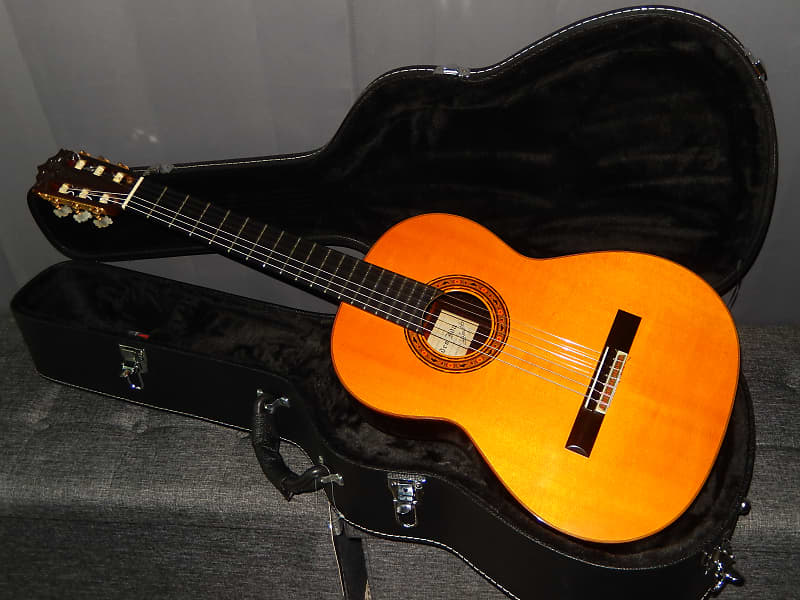

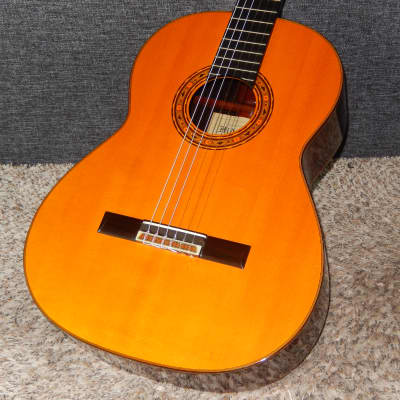
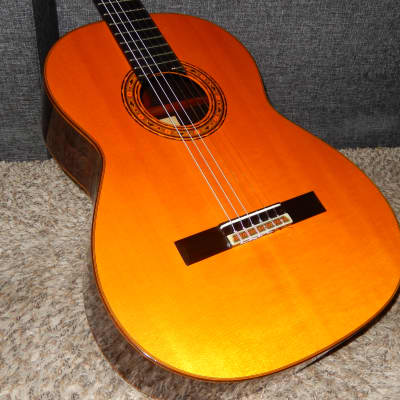
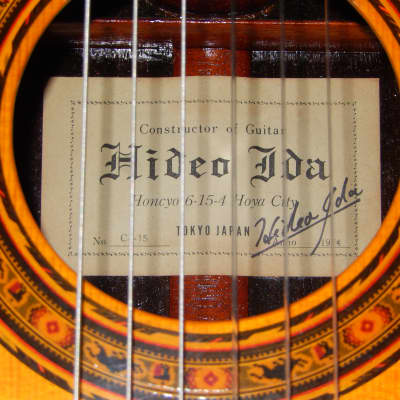
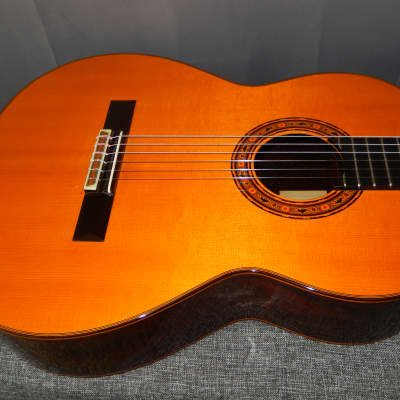
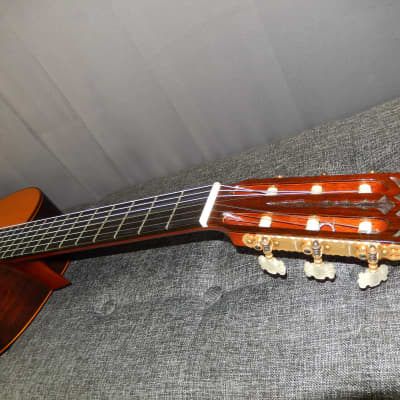
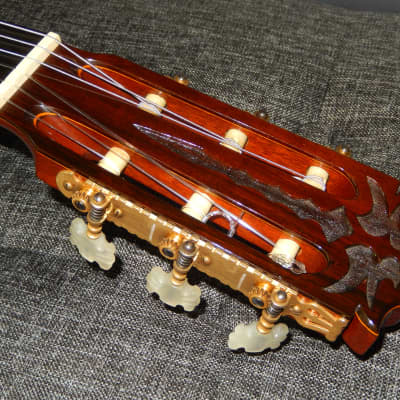
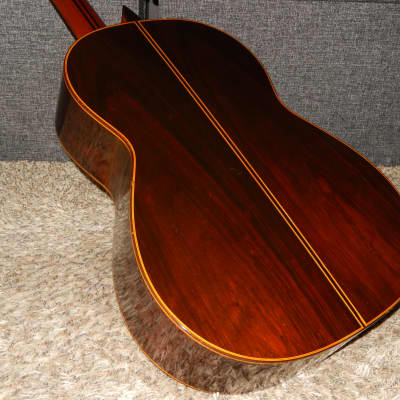
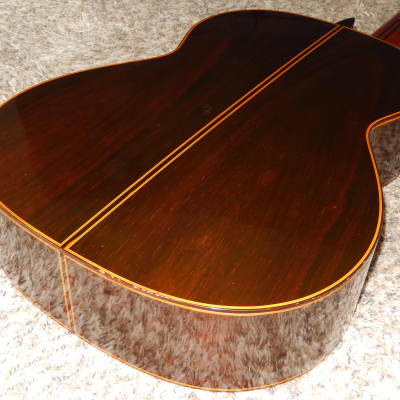
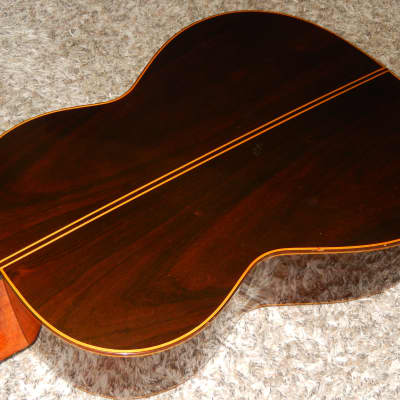
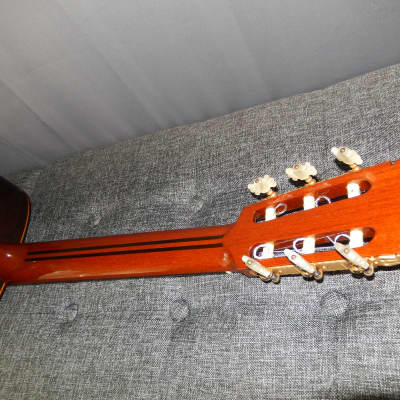
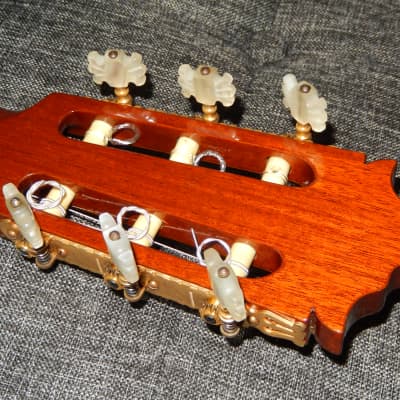
Several hundred guitars I have sold in the past are presented at Facebook.com/Victors.Guitar.Library.
Hideo Ida C-15 1975
This guitar was made and signed by Master Luthier Hideo Ida in 1974. It was his second from the top model of that era.
Hideo Ida has learned his craft as an associate of Sakazo Nakade (considered The Father of Modern Japanese Lutherie). Hideo established his own workshop in early 1970s and very quickly earned very high reputation among Japanese players. Hideo was making very limited number of guitars each year, all with uniquely carved headstocks and his design rosettes. His favorite motifs present on majority of his guitars, are a “raging bull” or “bull’s head”. They are incorporated into rosette design or sometimes into headstock carvings. His guitars very rarely appear on Japanese secondhand market, as they are highly sought by collectors and players alike.
In addition to their “super attractive” looks his guitars offer exceptional musical feasts for the players. This one is no different. It is a beauty in every regard. It is a very loud concert guitar, “full of honey and butter”, with deep and long resonating basses, with clean and sweet trebles that ring like bells. All notes well balanced and with great sustain. Guitar is responsive to a lightest touch. Sound wise it will satisfy the most demanding player.
Although I don’t know how many he still makes all by himself, Hideo’s guitars are made until today and they are very pricy. If ordered today the same looks and class (made from 50+ years old woods, with solid figured Brazilian Rosewood b/s and shellac finish) guitar would cost you minimum $12000USD. Yamaha charges $15000USD for their top-of-the-line GC70 model. Leading Spanish luthiers charge much more than that.
Overall condition of this gorgeous instrument can be described as “excellent for its age”. The only cosmetic flaws are few tiny dents and scratches on its top. There are also several tiny dents on the binding (most located along the bottom edge of the right back plate). Despite these imperfections guitar “looks and feels as if it was made yesterday”.
Specifications:
Top: High Grade Solid Spruce /shellac
Back & Sides: Solid Brazilian Rosewood /shellac
Neck: Mahogany with Ebony reinforcement
Fingerboard: Ebony
Scale: 655 mm
Nut width: 51.5 mm
The action is set to 3.5 mm under E6 and 3.00 mm under E1 with very little extra room on the saddle.
It will be shipped in brand new hard shell case.
When contemporary Japanese luthiers are using 40+ years old soundboards to make “all solid woods” guitar it is priced at least $5000USD. Guitars with artificially aged (“baked”) soundboards are priced at least $4500USD. Solid top models with 40+ years old soundboards are priced at least $3500USD. American, Australian and European luthiers usually charge 50% more.
It is a matter of basic education (not beliefs) to realize that 50+ years old soundboard of this guitar alone is worth $2500USD.
Real Value of Japanese Vintage Guitars
The key to understand value of vintage Japanese guitars is to acknowledge galloping price inflation (devaluation of Japanese yen) during 1960s & 1970s. This inflation slowed down in 1980s.
During 1960s and most of 1970s model numbers of Japanese guitars were strictly interconnected with their prices in Japanese yen. By early 1980s and during following decades model numbers were no longer strictly associated with their prices. Some Japanese guitar makers introduced model names instead of model numbers. Others were still using model numbers with addition of letters and/or other symbols.
It is then important to understand that two Yamaha GC10 guitars made 10 years apart are two instruments of totally different class. The same applies to any other Japanese maker/brand.
The logical way to estimate the true class of any given Japanese made instrument is to compare its price with the average annual salary of wage workers in Japanese private sectors. This salary was: 450 600 yen in 1965 - 825 900 yen in 1970 - 1 868 300 yen in 1975 - 2 689 000 yen in 1980 - 3 163 000 yen in 1985 - 3 761 000 yen in 1990 - 4 107 000 yen in 1995 - 4 082 000 yen in 2000.
Any guitar priced 100 000 yen in 1970 (labelled as No10 or No100) would be priced 200 000 yen in 1975 (relabeled to No20, No200 or 2000), 300 000 yen in 1977 (labelled as No3, No30 or 3000) and 500 000 yen by 1985 (labelled as No50 or 5000).
Starting in 1977 Masaru Kohno introduced his new models No40 priced 400 000 yen and No50 priced 500 000 yen. By early 1980s Kohno started using model names instead of numbers and was steadily raising their prices without changing model labeling. His very top model 50 became model “Special”, and a decade later it became model “Maestro”. Naturally, all other Japanese guitar makers were doing similar pricing (labelling) upgrades.
Knowing all of that, you can bet on that Masaru Kohno No50 made in 1982 is practically the same grade instrument as Kohno No20 made in 1972, or Kohno no 30 made in 1975.
In early 1970s the lowest Ryoji Matsuoka (all plywood) model was 10, followed by (solid top) models 15, 20, 25, 30, 40, 50, 60, 80 and (all solid woods) models 100 and 150. Models 50, 60 and 80 were made with non-solid figured Brazilian Rosewood (double) back and sides and top model 150 was the only one made with solid figured Brazilian Rosewood b/s.
In 1980 the lowest Matsuoka model was (all plywood) 20, followed by (solid top) models 30,40,50, 60 and all solid woods models 80,100,150 and 200. By 1990 the lowest Matsuoka model was M40 and the highest was M300. By 2010 the lowest Matsuoka model was M50 and the top model was M270.
You can bet that Ryoji Matsuoka model 50 from 1980 is of the same grade as model M100 from 2000, model 100 from 1980 is of the same grade as model M150 from 2000, model 150 from 1980 is of the same grade as M200 from 2000 and model 200 from 1980 is of the same grade as model M300 from 2000.
It is important to mention that if modern era luthiers are using 40+ years old woods to make an “all solid” wood classical guitar, its price is minimum $8000.
All vintage guitars made with Brazilian Rosewood are especially precious, including those made straight grain varieties and those with non-solid b/s.
Because response and tonal properties of Spruce soundboards are improving over time, long seasoned Spruces are far more precious than long seasoned Cedars.
It is not very difficult to find out what are current prices of such guitars made by world’s leading luthiers.
Reverb Buyer Protection
Reverb has your back if your item is lost, damaged, or doesn't match its description. Simply report any issues within 7 days and we'll help you get a full refund.Learn more about Reverb Buyer Protection.
| Listed | 2 years ago |
| Condition | Excellent (Used) Excellent items are almost entirely free from blemishes and other visual defects and have been played or used with the utmost care.Learn more |
| Brand |
|
| Model |
|
| Finish |
|
| Categories | |
| Year |
|
| Made In |
|
| Body Shape |
|
